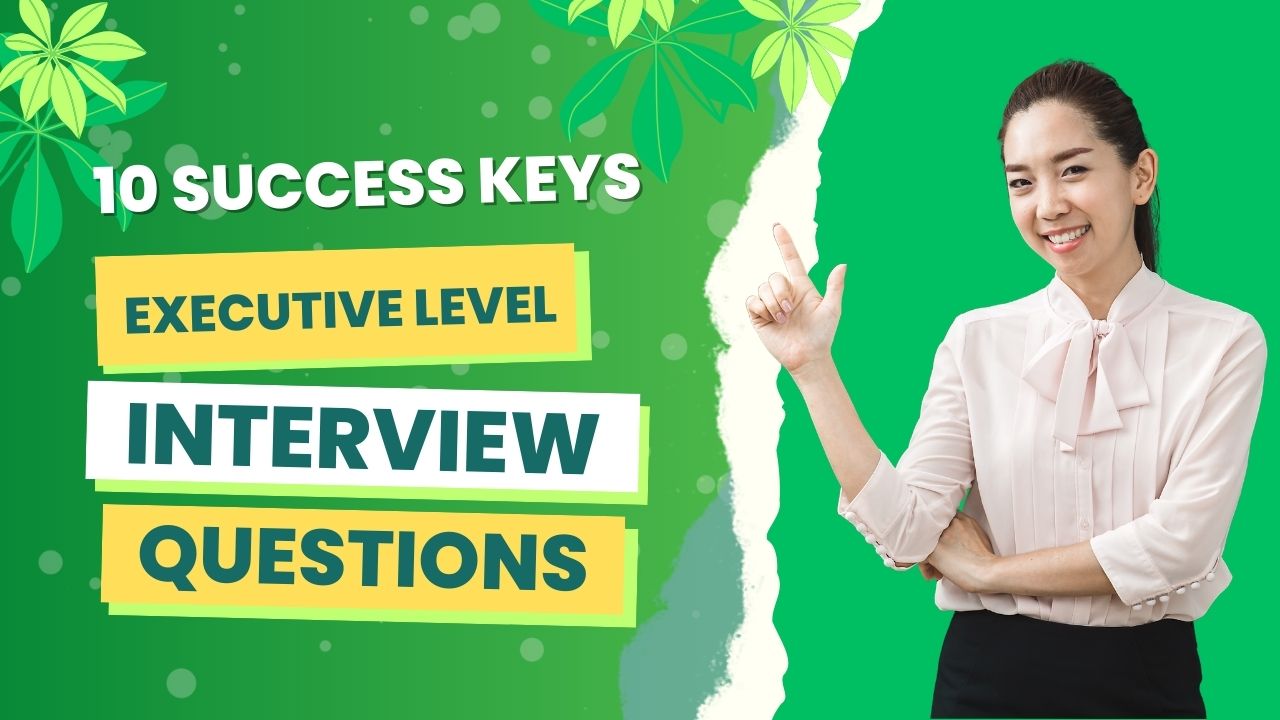Are you appearing for an executive level interview soon? Executive interviews are not much different from many other interviews. While being interviewed you are likely to be checked for multiple aspects. The interviewing panel will evaluate you for your experience and achievements alongside your individual qualities. You will be coming across executive level interview questions to highlight the strategic mindset, leadership qualities, cultural alignment, and long-term potential. It is important to remember that it is not just a manager but a visionary leader that employers are looking for.
The executive level jobs include CEO, CFO, COO, and similar executive roles. No matter which you’re you are appearing for, it is important to know how to respond in the executive interview. A well-crafted strategy and an understanding of the executive level interview questions are very important. Here in this guide, we will let you know the top 10 strategies to succeed in the executive level interview.
1. Understand the Executive Interview Landscape

What makes executive level interviews special is the fact that they are rigorous and multi-layered. They include panel interviews, presentations, case studies, and several rounds of strategic discussions. These interviews are different from the interviews of the junior roles. Unlike the latter which covers technical skills and their execution, the former focuses on business impact, long-term vision, emotional intelligence, and leadership qualities, especially under pressure.
The executives are required to have full command over external market trends, financial matters and regulatory landscapes. Most of the organizations are concerned of the ways you handle ambiguity, comfort level and your influence over key stakeholders at the board or investor level.
Tip: Research the company’s board members, leadership structure, quarterly goals, recent financials, and culture. These insights will help tailor your responses to what matters most to the organization.
In addition, it’s vital to prepare for the types of executive interview formats that might be used. Some companies may ask you to present a strategic plan within 48 hours or walk through a case study on a business turnaround. Practicing these scenarios can boost your confidence and performance.
2. Present Your Leadership Skills
As you appear before the hiring committee, they look for a future leader in you. They want to know if you have the potential to lead the team, develop talent, and take care of the people in hard situations. Generally, the committee will ask you to describe your leadership style.
Tip: In response to the question about the leadership style don’t just tell if it is transformational, servant, or else. Explain by giving any real-life example. Explain how you opted for the style in a growing organization in the past and changed things for the team you were mentoring. Don’t forget to mention the results, retention, or morale improvements.
Great leaders understand when to delegate, when to coach, and when to take decisive action. Also, reflect on how your leadership has evolved. Have you become more collaborative? More data-driven? What do your direct reports say about your leadership in 360° reviews?
Leadership in an executive context also means building leadership pipelines and fostering succession planning. Highlight your ability to identify high-potential individuals and prepare them for greater responsibilities within the organization.
3. Exhibit Strategic Decision-Making
C-suite roles demand strategic foresight. You’ll often be required to make decisions with incomplete information, under pressure, or amid organizational ambiguity. You may come across a question like “Tell us about a time you made a critical decision with limited data.”
Tip: Use the STAR (Situation, Task, Action, Result) method. For example, explain how you responded to a sudden market shift, consulted your leadership team, prioritized risk mitigation, and achieved business continuity.
You can also talk about the cross-functional impacts of the decision — such as how finance, operations, and marketing had to pivot — and what systems you put in place to monitor the results post-decision.
Strategic decision-making also includes budgeting, resource allocation, and aligning teams to execute against strategic priorities. Share how you translate a vision into actionable plans.
4. Align with Organizational Culture and Values

Cultural fit is a top priority in executive hiring. A misalignment can disrupt team dynamics and damage morale. Most of the interviewers at concerned about how your personal values and the organizational mission align?
Tip: Make sure to check the official site of the company to learn about their values before appearing for the executive interview. In this way, you can successfully refer to the company’s values and relate them to your leadership philosophy. Reference the company’s values (often found on their website or annual report) and relate them to your leadership philosophy. If a company emphasizes sustainability, share how you championed green initiatives or ESG reporting in past roles.
Also consider mentioning how you’ve previously led or adapted to cultural transformations — such as after mergers, acquisitions, or diversity initiatives. Share examples of shaping inclusive work environments or driving ethical decision-making during tough transitions.
5. Prepare for Behavioral Interview Questions
Behavioral questions help in predicting future performance based on past behavior. They help assess your emotional intelligence, conflict resolution ability, and integrity. You are expected to describe a time you had to resolve a conflict within your leadership team.
Tip: Outline the personalities involved, your intervention style, how you facilitated dialogue, and what the outcome was. Reflect on what you learned and how it shaped your leadership.
Go beyond just resolving the conflict. Share how you prevented future issues, such as changing the decision-making process or coaching individuals. Highlight your emotional intelligence, listening skills, and commitment to team harmony.
Behavioral responses should also reflect your agility in managing change, leading transformation projects, and maintaining alignment across departments.
6. Articulate Your Long-Term Vision
Executives have to think out of the box for future. They have to plan ahead, anticipate challenges, and inspire others toward a vision. Your ability to communicate a compelling, achievable strategy is critical. You are likely to respond to a question dealing with the future of the company in the next three to five years and how can you help.
Tip: Add pragmatism to your ambition and let the employees know that you are fully aware of their business model, market trends, and competitive threats. Then, share how your leadership will help the company grow.
Add how you bring others along with your vision — your ability to influence the board, mobilize the executive team, and energize employees across levels. This demonstrates both strategic clarity and executive influence.
Also mention how you use tools such as balanced scorecards, OKRs (Objectives and Key Results), and executive dashboards to keep the team aligned with long-term goals.
7. Demonstrate Accountability Through Metrics

Executives must quantify their contributions. It’s not enough to say you “improved performance” — you need to show the numbers. You must successfully answer about the role of KPIs that you use to measure success.
Tip: Choose relevant metrics — like EBITDA growth, cost savings, market share, and customer retention — and explain how you’ve moved the needle. Make it data-driven and impact-focused.
Additionally, highlight how you built performance dashboards, led KPI reviews, or aligned KPIs with strategic goals. Demonstrating how you tie performance to business outcomes shows maturity and results-focus.
8. Address Challenges and Show Resilience
Every executive face adversity — whether from competition, internal politics, or financial downturns. Your ability to remain composed, strategic, and solutions-oriented is key. In this regard one common question that the employers generally ask is, “Tell us about a major challenge you faced and how you overcame it.”
Tip: Don’t shy away from tough stories. Choose a scenario where the stakes were high, share your problem-solving approach, and emphasize lessons learned. Show grit and maturity.
You might talk about how you led a turnaround, navigated a major layoff, or handled a public relations crisis. Be honest, but emphasize recovery, growth, and how the experience shaped you.
9. Engage in High-Level Dialogue
Executive interviews are conversations. It has little to do with interrogations. You can come up with your own thoughtful questions. They will demonstrate insight, confidence, and interest in the company’s success.
Here are some questions that you can ask:
- What is the biggest strategic challenge facing your leadership team today?
- How does the board envision growth over the next five years?
- What qualities have made previous executives successful here?
Tip: Remember that the executive interview is a two-way assessment. Asking intelligent questions positions you as an equal, not a subordinate. Executive interview questions that you ask also show curiosity, readiness, and deep engagement with the company’s vision.
10. Use the STAR Method to Structure Responses
The STAR method (Situation, Task, Action, Result) is one of the best ways to structure executive responses. It provides clarity, structure, and demonstrates analytical thinking.
Tip: Before your executive interview, prepare 6–8 STAR stories besides preparing for executiv interview questions. These stories must cover different themes. The most demanded themes include innovation, leadership, conflict resolution, financial performance, change management, and customer strategy.
Make sure each story has clear outcomes. You can also create a quick-access “story bank” to draw from based on the flow of the conversation.
Final Thoughts
Executive level interview questions test your readiness to take on enterprise-level responsibilities. They require reflection, confidence, humility, and the ability to think strategically in real-time. Preparation is essential to answer the interview — but so is authenticity.
Approach interview questions not as a test, but as an opportunity to tell your story, share your vision, and connect your past achievements to the company’s future needs. And remember — you’re not just trying to get hired. You’re being invited to lead.
FAQs
Q1: What is the most important trait interviewers look for in the executive interview?
A: Strategic alignment with the company’s vision, combined with proven leadership and cultural fit.
Q2: How should I dress for an executive interview?
A: Always opt for executive-appropriate attire — think tailored, neutral, and professional. Your appearance should convey confidence and authority.
Q3: Should I follow up after an executive interview?
A: Yes. Send a personalized email thanking the interviewers, reiterating your interest, and referencing key points discussed.
Q4: How long will the executive interview take typically?
A: They can range from 1 to 3 hours, sometimes split into multiple sessions with different stakeholders.
Q5: How can I stand out in a competitive executive interview process?
A: Share quantifiable impact, show high emotional intelligence, and bring insight-driven questions to the table during the executive interview .


